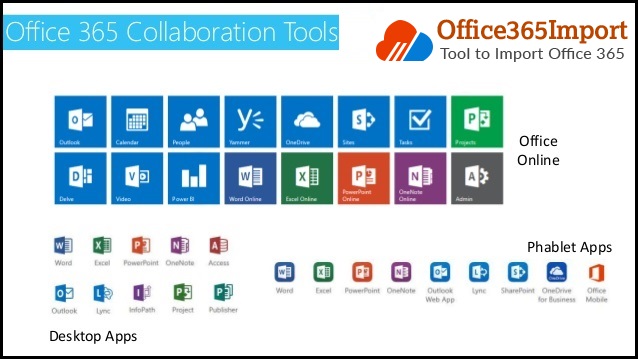Office 365 Collaboration Tools – Do You Know?
admin | Modified: December 19th, 2018 | Office 365
Cloud services have mobilized the companies to do what was once unachievable and Office 365 is one prime example of this ability. Microsoft Office 365 Collaboration Tools are widely used cloud-based subscription services, which brings together the best applications for the way users work today.

Via combining the best-in-class software with powerful cloud services, MS Office 365 lets users create and collaborate in any place through any device. Every group is different, with its own necessities and work style. Thus, Office 365 renders an integrated solution so that everyone can collaborate more effectively with co-authoring, team chats, online meetings, transfer files securely, group emails and in the social network to work.
Today, there are about 1 billion users who use Office 365 applications every day for communication, collaboration and get their work done. This application suite is handy for organizations as it improves the collaboration via transforming the firm Intranet into the social network. It improves the executive-employee relations and eliminates the generated barriers like time zones, physical distance, and workers utilizing multiple devices.
So, What is in the Office 365 Collaboration Tools Kit?
Microsoft provides the most complete set of productivity services presently available in the marketplace. It includes email messaging, compliance, content management, visualization, big data analysis, telephony, conferencing, and social collaboration. The Office 365 collaboration stack includes following applications:
- SharePoint Online Team, Communication, and Hub Sites
- One Drive for Business
- Outlook Groups
- Skype for Business
- Office 365 Groups
- Microsoft Teams
- Office Delve
- Office 365 Video
- Yammer
Usually, we all get lost in multiple collaboration applications, end-users can barely interpret the difference between them. Also, the organizations often hesitate over which Office 365 Collaboration Tools to use. Thus, let us analyze them separately.
#1: SharePoint Online Team, Communication, and Hub Sites
With the help of SharePoint Online team sites, individuals can quickly get a familiar homepage with the news feed, document libraries, and activity feed. Powered with the Microsoft Flow, SharePoint Online team sites assist workflows and allow employees to exchange information with other Microsoft or third-party applications. Teams also can utilize the data stored in SharePoint lists to generate the custom applications enabled along with Power Apps. Android, iOS, and Windows 10 Mobile apps support SharePoint on mobile devices thus, users can access their team sites any time they want.
Communication sites are for cross-team collaboration and they support the company-wide employee interaction. Everything that is published on the communication site will be automatically accessible from the whole community on their SharePoint home page, unlike the team sites, which keeps team collaboration private.
The major purpose of SharePoint hub sites is to put all the activities together, which are related to communication sites and SharePoint team on an individual collaboration area. Hub sites offer similar navigation and search across all the related sites. Hence, creating bunches of the SharePoint sites well-maintained and easy-to-follow.
#2: One Drive for Business
OneDrive for Business is an inbuilt part of Office 365 suite; it renders a place in the Cloud where users can share, stock, and sync their business files. Users can update as well as share their files via any device with the help of OneDrive for Business. Individuals are also allowed to work on the Office documents with other team users at the same time. It offers the much-required ability to administer the documents, content and share it internally as well as externally at a time with the accurate set of permissions. OneDrive lets sync client for mobile, desktop, and tablets with selective sync alternative to optimize the storage and share the content effectually. In addition, users can edit the content in real time according to their access permissions.
#3: Outlook Groups
Outlook Groups are the first to join Groups concept and to support the collaboration in the shared inbox. After creating an Outlook Group, users acquire a set of Office 365 collaboration tools, which includes:
- A Shared OneNote Notebook for taking group notes and other ideas.
- A SharePoint Team Site for enabling the full-fledged collaboration capabilities for group.
- A Planner for enabling the group task management.
- A shared Outlook inbox for supporting the email conversations between external users and group members.
- A shared calendar for managing the group events.
- A SharePoint document library for storing and sharing group files.
Outlook Groups are helpful for those workers who prefer the email-based collaboration.
#4: Skype for Business
As the Skype for Business Online barely comes into the spotlight, the application is an authorized member of the Office 365 suite. It allows users instant messaging, audio, video, VoIP, and the web conferencing. Well, it all depends on the subscription plan and Skype for Business also provide the benefits of other Office 365 tools, including file sharing, emailing, and data storage. Although Skype for Business is a full-fledged collaboration software, however, it is a handy utility to connect with the co-workers or business partners of your organization or around the world.
#5: Office 365 Groups
Microsoft Office 365 Groups is Cloud collaboration service to coordinate group efforts, communicate, and share the information. Office 365 Groups permits users to generate and negotiate ad hoc “groups” for the collaboration. The group offers members access for a shared inbox, calendar, and the file repository.
#6: Microsoft Teams
Teams is a chat-based workspace in the Office 365 Collaboration Tools. Microsoft Teams is completely a new occurrence which brings users, communications, and the content all together along with the tools that teams require. Thus, users can simply collaborate to accomplish more. It is naturally incorporated with familiar Office applications, i.e., Exchange, OneNote, Skype for Business, Planner, SharePoint, and Delve. It is built from the ground up on Office 365 global, secure Cloud. This chat solution enables users to quickly ping the individuals and particular groups for the information and check the historical view of conversations. With Microsoft Teams, group members can generate new documents, upload data files and share data items with other associates and groups.
#7: Office Delve
Delve is an employee profile that makes the content discovery easy for collaboration and helps users to find the right person or the right content when required. It acts as a tool to control all the essential business content in a single place. Office Delve is a new technique to discover the relevant information and links from across users’ work life. It displays information, which is most relevant for every person based on the work that they are doing and the users with whom they are getting engaged.
#8: Office 365 Video
Office 365 Video is just like as YouTube, however, it is for business. Users can make multiple channels secured to access where one can tag the users for easy findability. This dynamic video portal is available for Office 365 customers. It lets effortless playback of videos, file uploading, as well as data sharing, securely throughout the organization. This portal is developed to meet the requirements of IT users.
#9: Yammer
Yammer is such a simple way to collaborate with the team, share information, and engage with everyone in the organization. It benefits Office 365 groups and executes smooth Office suite integration to effectively collaborate with the internal as well as external stakeholders.
Must Read: Office 365 DLP Policy Tips Not Working
Concluding Lines
Users always demand ease as well as the capability to collaborate without having deep technical expertise. Office 365 Collaboration tools are excellent productivity applications that are widely utilized for enterprise collaboration and data management. In this technical paper, we have discussed all the essential applications that can boost the productivity of companies and employees.



